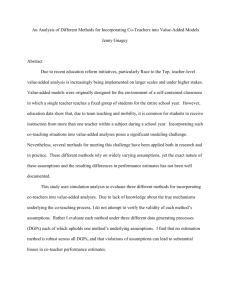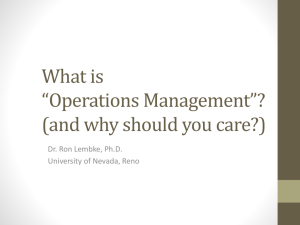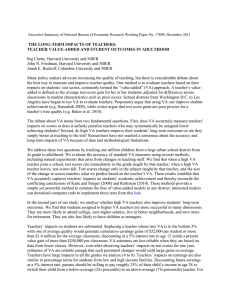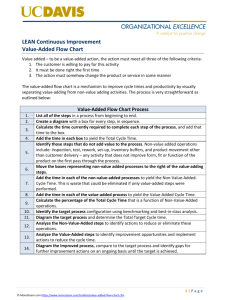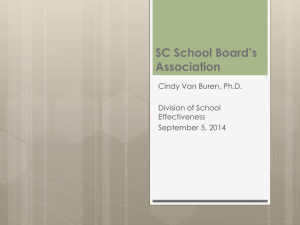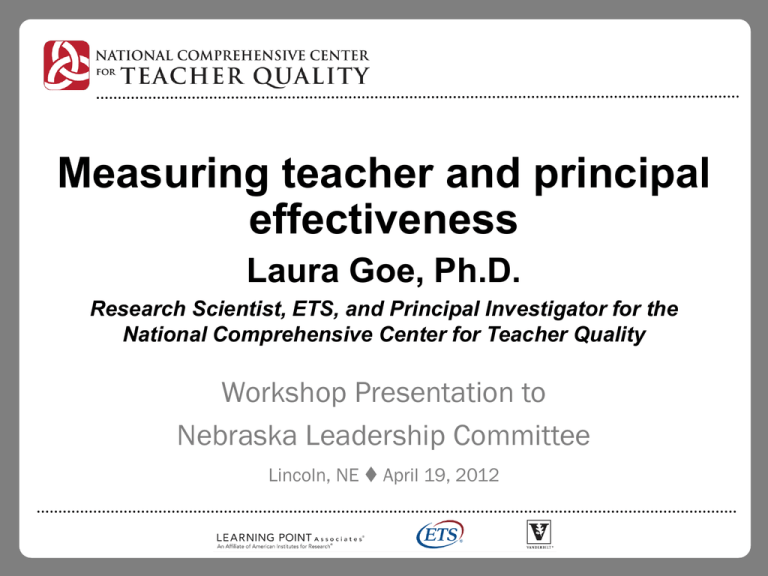
Measuring teacher and principal
effectiveness
Laura Goe, Ph.D.
Research Scientist, ETS, and Principal Investigator for the
National Comprehensive Center for Teacher Quality
Workshop Presentation to
Nebraska Leadership Committee
Lincoln, NE April 19, 2012
Laura Goe, Ph.D.
• Former teacher in rural & urban schools
Special education (7th & 8th grade, Tunica, MS)
Language arts (7th grade, Memphis, TN)
• Graduate of UC Berkeley’s Policy, Organizations,
Measurement & Evaluation doctoral program
• Principal Investigator for the National
Comprehensive Center for Teacher Quality
• Research Scientist in the Performance Research
Group at ETS
2
The National Comprehensive Center
for Teacher Quality
• A federally-funded partnership whose
mission is to help states carry out the
teacher quality mandates of ESEA
• Vanderbilt University
• Learning Point Associates, an affiliate of
American Institutes for Research
• Educational Testing Service
3
Today’s presentation available online
• To download a copy of this presentation go
to www.lauragoe.com
Go to Publications and Presentations page
Today’s presentation is at the bottom of the
page
4
To be discussed…
•
•
•
•
•
•
•
•
•
•
•
•
•
A new era in teacher and principal evaluation
An aligned systems of teacher and principal evaluation
Developing a shared vocabulary
Components of teacher and principal evaluation systems
Student, parent, and staff feedback measures
Professional responsibility measures and other valued actions
Weighting components of the evaluation model
Frontier and rural school models
Professional growth opportunities aligned with evaluation results
Merit pay and teacher retention
Teacher preparation programs
Principal evaluation standards and instruments
Moving forward: next steps
5
The goal of teacher evaluation
The ultimate goal of all
teacher evaluation should be…
TO IMPROVE
TEACHING AND
LEARNING
6
Trends in teacher evaluation
• The policy imperative to change teacher evaluation
has outstripped the research
Though we don’t yet know which model and combination of
measures will identify effective teachers, many states and
districts feel compelled to move forward at a rapid pace
• Inclusion of student achievement growth data
represents an important “culture shift” in evaluation
Communication and teacher/administrator participation and
buy-in are crucial to ensure change
• The implementation challenges are considerable
We are models exist for states and districts to adopt or adapt
Many districts have limited capacity to implement comprehensive
systems, and states have limited resources to help them
7
It’s an equity issue
• Value-added research shows that teachers
vary greatly in their contributions to student
achievement (Rivkin, Hanushek, & Kain,
2005).
• The Widget Effect report (Weisberg et al.,
2009) found that 90% of teachers were
rated “good” or better in districts where
students were failing at high levels
8
An aligned teacher evaluation system:
Part I
Teaching
standards: high
quality state or
INTASC standards
(taught in teacher
prep program,
reinforced in
schools)
Measures of
teacher
performance
aligned with
standards
Evaluators
(principals,
consulting
teachers, peers)
trained to
administer
measures
Instructional
leaders (principals,
coaches, support
providers) to
interpret results in
terms of teacher
development
High-quality
professional
growth
opportunities for
individuals and
groups of teachers
with similar
growth plans
9
An aligned teacher evaluation system:
Part II
Results from teacher
evaluation inform
evaluation of
teacher evaluation
system (including
measures, training,
and processes)
Results from teacher
evaluation inform
planning for
professional
development and
growth
opportunities
Results from teacher
evaluation and
professional growth
are shared (with
privacy protection)
with teacher
preparation
programs
Results from teacher
evaluation and
professional growth
are used to inform
school leadership
evaluation and
professional growth
Results from teacher
and leadership
evaluation are used
for school
accountability and
district/state
improvement
planning
10
“Effective” vs. “Highly Qualified”
• The focus has shifted away from ensuring
highly qualified teachers in every
classroom to ensuring effective teachers
in every classroom
• This shift is a result of numerous studies
that show that qualifications provide a
“floor” or “minimum” set of competencies
but do not predict which teachers will be
most successful at helping students learn
11
Definitions in the research & policy
worlds
• Much of the research on teacher effectiveness
doesn’t define effectiveness at all though it is
often assumed to be teachers’ contribution to
student achievement
• Bryan C. Hassel of Public Impact stated in 2009
that “The core of a state’s definition of teacher
effectiveness must be student outcomes”
• Checker Finn stated in 2010 that “An effective
teacher is one whose pupils learn what they
should while under his/her tutelage”
12
Definitions in the research & policy
worlds (2)
Anderson (1991) stated that “… an effective
teacher is one who quite consistently
achieves goals which either directly or
indirectly focus on the learning of
their students” (p. 18).
13
Definitions in the research & policy
worlds (3)
Hunt (2009) stated that, “…the term “teacher
effectiveness” is used broadly, to mean the
collection of characteristics, competencies, and
behaviors of teachers at all educational levels that
enable students to reach desired outcomes, which
may include the attainment of specific learning
objectives as well as broader goals such as being
able to solve problems, think critically, work
collaboratively, and become effective citizens.
(p. 1)
14
Goe, Bell, & Little (2008) definition of
teacher effectiveness
1. Have high expectations for all students and help students learn, as
measured by value-added or alternative measures.
2. Contribute to positive academic, attitudinal, and social outcomes for
students, such as regular attendance, on-time promotion to the next
grade, on-time graduation, self-efficacy, and cooperative behavior.
3. Use diverse resources to plan and structure engaging learning
opportunities; monitor student progress formatively, adapting
instruction as needed; and evaluate learning using multiple sources of
evidence.
4. Contribute to the development of classrooms and schools that value
diversity and civic-mindedness.
5. Collaborate with other teachers, administrators, parents, and
education professionals to ensure student success, particularly the
success of students with special needs and those at high risk for
failure.
15
Race to the Top definition of
effective & highly effective teacher
Effective teacher: students achieve acceptable rates
(e.g., at least one grade level in an academic year) of
student growth (as defined in this notice). States,
LEAs, or schools must include multiple measures,
provided that teacher effectiveness is evaluated, in
significant part, by student growth (as defined in this
notice). Supplemental measures may include, for
example, multiple observation-based assessments of
teacher performance. (pg 7)
Highly effective teacher students achieve high rates
(e.g., one and one-half grade levels in an academic
year) of student growth (as defined in this notice).
16
Measures and models: Definitions
• Measures are the instruments,
assessments, protocols, rubrics, and tools
that are used in determining teacher
effectiveness
• Models are the state or district systems of
teacher evaluation including all of the inputs
and decision points (measures, instruments,
processes, training, and scoring, etc.) that
result in determinations about individual
teachers’ effectiveness
17
Teaching standards
• A set of practices teachers should aspire to
• A teaching tool in teacher preparation programs
• A guiding document with which to align:
Measurement tools and processes for teacher
evaluation, such as classroom observations, surveys,
portfolios/evidence binders, student outcomes, etc.
Teacher professional growth opportunities, based on
evaluation of performance on standards
• A tool for coaching and mentoring teachers:
Teachers analyze and reflect on their strengths and
challenges and discuss with consulting teachers
18
Who should be at the table?
• “An SEA must meaningfully engage and solicit input
from diverse stakeholders and communities in the
development of its request.” (NCLB Waiver
application, pg. 15)
A description of how the SEA meaningfully engaged and
solicited input on its request from teachers and their
representatives.
A description of how the SEA meaningfully engaged and
solicited input on its request from other diverse communities,
such as students, parents, community-based
organizations, civil rights organizations, organizations
representing students with disabilities and English
Learners, business organizations, and Indian tribes.
19
Multiple measures of teacher
effectiveness
• Evidence of growth in student learning and
competency
Standardized tests, pre/post tests in untested subjects
Student performance (art, music, etc.)
Curriculum-based tests given in a standardized manner
Classroom-based tests such as DIBELS
• Evidence of instructional quality
Classroom observations
Lesson plans, assignments, and student work
Student surveys such as Harvard’s Tripod
Evidence binder (next generation of portfolio)
• Evidence of professional responsibility
Administrator/supervisor reports, parent surveys
Teacher reflection and self-reports, records of contributions
20
Teacher observations: strengths and
weaknesses
• Strengths
Great for teacher formative evaluation (if observation is
followed by opportunity to discuss)
Helps evaluator (principals or others) understand
teachers’ needs across school or across district
• Weaknesses
Only as good as the instruments and the observers
Considered “less objective”
Expensive to conduct (personnel time, training,
calibrating)
Validity of observation results may vary with who is
doing them, depending on how well trained and
calibrated they are
21
Why teachers generally value
observations
• Observations are the traditional measure of teacher
performance
• Teachers feel they have some control over the
process and outcomes
• They report that having a conversation with the
observation and receiving constructive feedback
after the observation is greatly beneficial
• Evidence-centered discussions can help teachers
improve instruction
• Peer evaluators often report that they learn new
teaching techniques
22
When teachers don’t value
observations, it’s because…
• They do not receive feedback at all
• The feedback they receive is not specific
and actionable
• The observer suggests actions but is
unable to offer the means and resources to
carry out those actions
Mentors/coaches, other support personnel
Time for individual growth planning/activities
Protected time for collaboration with others
23
Validity of classroom observations is
highly dependent on training
• A teacher should get the same score no matter
who observes him
This requires that all observers be trained on the
instruments and processes
Occasional “calibrating” should be done; more
often if there are discrepancies or new observers
Who the evaluators are matters less than
adequate training
Teachers should be trained on the observation
forms and processes
24
Reliability results when using different
combinations of raters and lessons
Figure 2. Errors and
Imprecision: the reliability of
different combinations of
raters and lessons. From Hill
et al., 2012 (see references
list). Used with permission of
author.
25
Cincinnati study results
• Study by Kane et al. (2010) used teacher evaluation
scores plus value-added scores
“…policies and programs that help a teacher get better
on all eight ‘teaching practice’ and ‘classroom
environment’ skills measured by TES will lead to student
achievement gains” (p. 28)
“…helping teachers improve their ‘classroom
environment’ management will likely also generate higher
student achievement” (p. 28)
“…[adding] pedagogy that utilizes ‘questioning and
discussion’ practices will generate higher reading
achievement, but not higher math achievement” (p. 28)
26
Value-added models
• Many variations on value-added models
TVAAS (Sander’s original model) typically uses
3+ years of prior test scores to predict the next
score for a student
- Used since the 1990’s for teachers in Tennessee, but
not for high-stakes evaluation purposes
- Most states and districts that currently use VAMs use
the Sanders’ model, also called EVAAS
There are other models that use less student
data to make predictions
Considerable variation in “controls” used
27
27
Growth vs. Proficiency Models
Achievement
Proficient
In terms of
growth,
Teachers A
and B are
performing
equally
Teacher A:
“Success” on
Ach. Levels
Teacher B:
“Failure” on Ach.
Levels
Start of School Year
End of Year
Slide courtesy of Doug Harris, Ph.D, University of Wisconsin-Madison
28
Growth vs. Proficiency Models (2)
Achievement
Proficient
Teacher A
A teacher
with lowproficiency
students can
still be high
in terms of
GROWTH
(and vice
versa)
Teacher B
Start of School Year
End of Year
Slide courtesy of Doug Harris, Ph.D, University of Wisconsin-Madison
29
Most popular growth models:
Colorado Growth Model
• Colorado Growth model
Focuses on “growth to proficiency”
Measures students against “academic peers”
Also called criterion‐referenced growth‐to‐standard
models
• The student growth percentile is
“descriptive” whereas value-added seeks
to determine the contribution of a school or
teacher to student achievement
(Betebenner 2008)
30
An illustration of student growth over time
in Denver, CO
Slide courtesy of Damian Betebenner at www.nciea.org
31
What value-added and growth models
cannot tell you
• Value-added and growth models are really
measuring classroom, not teacher, effects
• Value-added models can’t tell you why a
particular teacher’s students are scoring
higher than expected
Maybe the teacher is focusing instruction
narrowly on test content
Or maybe the teacher is offering a rich,
engaging curriculum that fosters deep student
learning.
• How the teacher is achieving results matters!
32
Measuring teachers’ contributions to
student learning growth (classroom)
33
Race to the Top definition of student
growth
• Student growth means the change in
student achievement (as defined in
this notice) for an individual student
between two or more points in time. A
State may also include other
measures that are rigorous and
comparable across classrooms. (pg
11)
34
34
Measuring teachers’ contributions to student learning
growth: A summary of current models
Model
Description
Student learning
objectives
Teachers assess students at beginning of year and set
objectives then assesses again at end of year; principal
or designee works with teacher, determines success
Subject & grade
alike team models
Teachers meet in grade-specific and/or subject-specific
teams to consider and agree on appropriate measures
that they will all use to determine their individual
contributions to student learning growth
Pre-and post-tests
model
Identify or create pre- and post-tests for every grade
and subject
School-wide valueadded
Teachers in tested subjects & grades receive their own
value-added score; all other teachers get the schoolwide average
35
School-wide VAM illustration
8
7
6
5
4
Obs/Surv
VAM
3
2
1
0
36
DC Impact: Score comparison for
Groups 1-3
Group 1
(tested
subjects)
Group 2
(non-tested
subjects)
Group 3
(special
education)
Teacher value-added (based
on test scores)
50%
0%
0%
Teacher-assessed student
achievement (based on nonVAM assessments)
0%
10%
10%
Teacher and Learning
Framework (observations)
35%
75%
55%
The rest of the 100%: All teachers receive 10% “Commitment to School Community” and 5%
schoolwide average value-added. In addition, Special Education teachers receive 10% for IEP
timeliness and 10% Eligibility timeliness (“…a measure of the extent to which the special
education eligibility process required for the students on your caseload is completed within
37
the timeframe”).
Validity
• There is little research-based support for the
validity of using student growth measures for
teacher evaluation
Mainly because using student growth
measures in evaluation hasn’t been done
• Herman et al. (2011) state, “Validity is a
matter of degree (based on the extent to
which an evidence-based argument justifies
the use of an assessment for a specific
purpose).” (pg. 1)
38
IF
Standards clearly define learning
expectations for the subject area
and each grade level
AND
Assessment scores represent
teachers’ contribution to student
growth
THEN
AND IF
The assessment instruments have
been designed to yield scores that
can accurately reflect student
achievement of standards
Student growth scores accurately
and fairly measure student
progress over the course of the
year
AND IF
AND
There is evidence that the
assessment scores actually measure
the learning expectations
Interpretation of
scores may be
appropriately
used to inform
judgments about
teacher
effectiveness
The assessment instruments have
been designed to yield scores that
accurately reflect student learning
growth over the course of the year
AND IF
Copyright © 2009 National Comprehensive Center for Teacher Quality. All rights reserved.
Propositions that justify the use of these measures for evaluating teacher effectiveness. (Adaptation based on Bailey & Heritage, 2010 and
Perie & Forte (in press)) (Herman, Heritage & Goldschmidt, 20ll ). Slide used courtesy of Margaret Heritage.
Validity is a process
• Starts with defining the criteria and
standards you want to measure
• Requires judgment about whether the
instruments and processes are giving
accurate, helpful information about
performance
• Verify validity by
Comparing results on multiple measures
Multiple time points, multiple raters
40
The 4 Ps (Projects, Performances,
Products, Portfolios)
• Some learning is best measured with an
assessments other than a standardized test
• Yes, they can be used to demonstrate teachers’
contributions to student learning growth
• Here’s the basic approach
Use a high-quality rubric to judge initial knowledge
and skills required for mastery of the standard(s)
Use the same rubric to judge knowledge and skills at
the end of a specific time period (unit, grading period,
semester, year, etc.)
41
Assessing Musical Behaviors: The type of
assessment must match the knowledge or skill
4 types of musical behaviors:
1.Responding
2.Creating
3.Performing
4.Listening
Types of assessment
1.
2.
3.
4.
5.
6.
7.
Rubrics
Playing tests
Written tests
Practice sheets
Teacher Observation
Portfolios
Peer and SelfAssessment
Slide used with permission of authors Carla Maltas, Ph.D. and Steve
Williams, M.Ed. See reference list for details.
Georgia CLASS KEYS
43
Washington DC IMPACT:
Rubric for Determining Success (for teachers in nontested subjects/grades)
44
Washington DC IMPACT:
Rubric for Determining Success (for teachers in nontested subjects/grades)
45
The “caseload” educators
• For nurses, counselors, librarians and
other professionals who do not have their
own classroom, what counts for you is
your “caseload”
May be all the students in the school
May be a specific set of students
May be other teachers
May be all of the above!
46
Other teachers with “caseloads”
• For team teachers, special ed teachers,
ELL teachers, other itinerant teachers
Caseload would be the students you provide
instruction or assistance to
When students are shared between two
teachers, those students belong to both
teachers’ caseloads
This may be done as a percentage, or the
shared student scores would be counted for
each teacher
47
Tripod Survey (1)
• Harvard’s Tripod Survey – the 7 C’s
– Caring about students (nurturing productive
relationships);
– Controlling behavior (promoting cooperation and
peer support);
– Clarifying ideas and lessons (making success
seem feasible);
– Challenging students to work hard and think hard
(pressing for effort and rigor);
– Captivating students (making learning interesting
and relevant);
– Conferring (eliciting students’ feedback and
respecting their ideas);
– Consolidating (connecting and integrating ideas to
support learning)
48
Tripod Survey (2)
• Improved student performance depends on strengthening
three legs of teaching practice: content, pedagogy, and
relationships
• There are multiple versions: k-2, 3-5, 6-12
• Measures:
student engagement
school climate
home learning conditions
teaching effectiveness
youth culture
family demographics
• Takes 20-30 min
• There are English and Spanish versions
• Comes in paper form or in online version
49
Tripod Survey (3)
• Control is the strongest correlate of value
added gains
• However, it is important to keep in mind
that a good teacher achieves control by
being good on the other dimensions
50
Tripod Survey (4)
• Different combinations of the 7 C's predict different
outcomes (student learning is one outcome)
• Using the data, you can determine what a teacher
needs to focus on to improve important outcomes
• Besides student learning, other important
outcomes include:
happiness
good behavior
healthy responses to social pressures
self-consciousness
engagement/effort
satisfaction
51
Measuring teachers’ contributions to
student learning growth: Rural challenges
• Teachers who are seen as “outsiders” may have
problems building positive relationships with
students and engaging them in learning
Help teacher get connected to community by
assigning a community mentor to help teacher
integrate into local culture
Use place-based learning strategies to engage
students and teachers in discovering local history and
culture while addressing community needs
Provide professional development on “cultural
relativism”
52
Measuring teachers’ contributions to
student learning growth: Frontier Model
• Highly mobile student populations
Assess entering students’ knowledge and
skills as soon as possible
More frequent assessments of students’
progress
Less weight on once-a-year standardized
tests for measuring a teacher’s contribution
since the teacher may have had a limited
opportunity to impact student learning
53
Frontier Model: Assessing student
growth for teacher evaluation
• Mobile student populations
Short-cycle assessments will work better for students
who are highly mobile
• High student absenteeism
Develop specific guidelines for how many total days,
consecutive days, etc. a student must be on a
teacher’s role to “count” for that teachers’ score on
contribution to student learning
• Students who need support
Evaluate teachers’ efforts to address students’
physical, social, and emotional needs
- Evaluate contacts and relationships with parents
54
Frontier Model: Teacher collaboration
• Teachers don’t need to assess in isolation
Collaborate/share great lesson plans, materials,
assessments, etc. across classrooms, schools,
and districts (by content area, grades taught)
Work together to grade projects, essays, etc. by
using technology when meeting in person is not
feasible
- Develop consistency in scoring, ensuring that results
from student assessments are more valid
Webex and other web-based programs allow you
to share files, videos, assessments, and rubrics
55
Frontier Model: Gaining parent
support for teaching and learning
• Support teachers in building relationships
with community and parents
Especially important for teacher retention
Connect them with a community guide/mentor
• Engage community in celebrating student
success
Share student work throughout the year in
community exhibits, performances, etc.
Ask parents to assist in and contribute their
talents and skills to these events
56
Frontier model: District/state support
• Invest in technology and infrastructure that
will enable teachers to connect with each
other and with internet-based resources
• Form regional consortiums to share
resources including personnel
Isolated rural schools may not be able to
afford their own data analysts, curriculum
specialists, etc.
Need a model of sharing personnel across
regions
57
Measures that help teachers grow
• Measures that motivate teachers to examine their own
practice against specific standards
• Measures that allow teachers to participate in or co-construct
the evaluation (such as “evidence binders”)
• Measures that give teachers opportunities to discuss the
results with evaluators, administrators, colleagues, teacher
learning communities, mentors, coaches, etc.
• Measures that are aligned with professional development
offerings
• Measures which include protocols and processes that
teachers can examine and comprehend
58
Results inform professional growth
opportunities
• Are evaluation results discussed with individual
teachers?
• Do teachers collaborate with instructional
managers to develop a plan for improvement
and/or professional growth?
All teachers (even high-scoring ones) have areas
where they can grow and learn
• Are effective teachers provided with opportunities
to develop their leadership potential?
• Are struggling teachers provided with coaches
and given opportunities to observe/be observed?
59
Why you should keep (and provide
support to) the less effective teachers
• With the right instructional strategies and
guidance, motivated teachers can improve
practice and student outcomes
• The teachers you hire to replace your less
effective teachers are not necessarily going to be
more effective
• You may not be able to find better replacements!
• You may not be any to find any replacements!
• The replacements you find may not stay
60
Performance pay for teachers
• Am Assn of School Administrators survey,
52% rural respondents (Ellerson, 2009)
45% expressed moderate-to-strong interest in
pay for performance
20% who don’t support pay for performance
contend that “…good teachers are already
doing the best they can, and performance‐
based pay is highly unlikely to improve their
teaching ability…poor and mediocre teachers
do not become better teacher because more
money is offered.”
61
Performance pay may improve
retention of effective teachers
• Little evidence that pay-for-performance
improves student outcomes, but it does
impact teacher retention in high-poverty,
low-achieving schools (Springer et al., 2009)
• Thus, financial incentives for effective
teachers may work as a signal to them that
they are successful, and successful
teachers are more likely to stay in
placements
62
Evaluating Teacher Preparation
Programs (TPPs)
Evaluate teacher performance
(including student outcomes)
Use results as a measure of TPP
success (for evaluation purposes)
Use results to improve TPP curriculum
and instruction
K-12 Teaching and learning improves
as a result of changes made by TPPs
63
Meeting the “standards”
• It’s possible to be meeting accreditation
standards (NCATE, TEAC) but still not be
preparing fully effective teachers
• If TPPs are not adequately preparing
teachers for the contexts and
communities which they serve, their
effectiveness may be hampered
64
VAMs and Teacher Prep Program
evaluation/assistance
• VAMs may be useful in identifying teacher
preparation programs (TPPs) whose
graduates are not performing at acceptable
levels in terms of student gains
However, VAMs cannot be used to diagnose why
the TPP’s graduates are failing to meet student
progress goals
Additional information should be gathered from the
TPP in order to properly diagnose problems
TPPs can then be provided with guidance and
support to address specific needs
65
TPP Selectivity and Consequences
• TPPs vary in selectivity in the admissions
process
So the quality of candidates is in large part
dependent on the selectivity of the TPP
Unless you “control” for this factor statistically, you
will punish schools that are less selective because
their candidates will likely not perform as well in
their placements
- If, however, you wish to send a signal to TPPs that they
should be more selective, you would not control for
selectivity
66
General Suggestions
• Examine relationships among teachers’ survey
responses and student learning growth
Those correlations may be very useful in driving
subsequent research and discussions about
program effectiveness
• Oversight: Ensure that TPPs are directed to
focus on addressing the issues that teachers
consider most important (survey results)
Classroom management
Differentiating instruction
67
Principal Effectiveness: New Leaders for
New Schools Definition
“New Leaders for New Schools advocates
for an evidence-based, three-pronged
approach to defining principal effectiveness:
1) gains in student achievement, 2)
increasing teacher effectiveness, and 3)
taking effective leadership actions to reach
these outcomes.”
http://www.newleaders.org/wpcontent/uploads/2011/08/principal_effectiveness_nlns_overview.pdf
68
Principal Effectiveness: Center for
American Progress on Principal Evaluation
• Student achievement measures including schoolwide academic
growth, attainment measures of achievement, and cohort graduation
rates
• Recruiting, developing, and retaining effective teachers and effectively
implementing teacher evaluations to improve teacher effectiveness
and/or retain effective teachers at higher rates while reducing the
number of ineffective performers
• Research-based rubrics that assess principals against performance
standards
• Measures of school culture and climate, such as teacher and student
attendance, indicators of school discipline, and parent, student, and
staff perceptions
Summarized from http://www.americanprogress.org/issues/2011/03/pdf/principalproposalmemo.pdf
69
Principal Evaluation: Interstate School Leaders
Licensure Consortium (ISLLC) Standards
Standard 1: A school administrator is an educational leader who
promotes the success of all students by facilitating the
development, articulation, implementation, and stewardship of a
vision of learning that is shared and supported by the school
community.
Standards 2: A school administrator is an educational leader who
promotes the success of all students by advocating, nurturing,
and sustaining a school culture and instructional program
conducive to student learning and staff professional growth.
Standard 3: A school administrator is an educational leader who
promotes the success of all students by ensuring management of
the organization, operations, and resources for a safe, efficient,
and effective learning environment.
70
Principal Evaluation: Interstate School Leaders
Licensure Consortium (ISSLC) Standards (cont’d)
Standard 4: A school administrator is an educational leader who
promotes the success of all students by collaborating with families
and community members, responding to diverse community
interests and needs, and mobilizing community resources.
Standard 5: A school administrator is an educational leader who
promotes the success of all students by acting with integrity,
fairness, and in an ethical manner.
Standard 6: A school administrator is an educational leader who
promotes the success of all students by understanding,
responding to, and influencing the larger political, social,
economic, legal, and cultural context.
71
Vanderbilt Assessment of Leadership in Education (VAL-Ed)
72
72
Teachers and leaders are the key
• Strong, effective teachers and leaders are the
key to improving student outcomes
• Two ways to get effective teachers and
leaders:
Remove less effective teachers and leaders and
replace them with more effective ones
- Not the preferred option, particularly for isolated
rural or hard-to-staff urban schools
Provide guidance and support to help less
effective teachers and leaders improve
performance
73
Considerations for choosing and
implementing measures
• Consider whether human resources and capacity are
sufficient to ensure fidelity of implementation
• Conserve resources by encouraging districts to join
forces with other districts or regional groups
• Establish a plan to evaluate measures to determine if
they can effectively differentiate among teacher
performance
• Examine correlations among measures
• Evaluate processes and data each year and make
needed adjustments
74
Final thoughts
• The limitations:
There are no perfect measures
There are no perfect models
Changing the culture of evaluation is hard work
• The opportunities:
Evidence can be used to trigger support for struggling
teachers and acknowledge effective ones
Multiple sources of evidence can provide powerful
information to improve teaching and learning
Evidence is more valid than “judgment” and provides
better information for teachers to improve practice
75
Resources and links
• Memphis Professional Development System
Main site: http://www.mcsk12.net/aoti/pd/index.asp
PD Catalog:
http://www.mcsk12.net/aoti/pd/docs/PD%20Catalog%20Spring%20
2011lr.pdf
Individualized Professional Development Resource Book:
http://www.mcsk12.net/aoti/pd/docs/Resource%20guide%201111.pdf
• Harvard’s Tripod Survey
http://www.tripodproject.org/index.php/index/
• National Response to Intervention Center Progress Monitoring
Tools
http://www.rti4success.org/chart/progressMonitoring/progress
monitoringtoolschart.htm
76
Resources and links (cont’d)
• Colorado Content Collaboratives
http://www.cde.state.co.us/ContentCollaboratives/index.asp
• Harvard’s Tripod Survey
http://www.tripodproject.org/index.php/index/
• Louisiana Student Growth for Non-tested Subjects
http://www.louisianaschools.net/compass/sgm_nontested.html
• National Response to Intervention Center Progress Monitoring Tools
http://www.rti4success.org/chart/progressMonitoring/progressmonito
ringtoolschart.htm
• New York State approved teacher and principal practice rubrics
http://usny.nysed.gov/rttt/teachers-leaders/practicerubrics/
• Rhode Island Department of Education Teacher Evaluation –
Student Learning Objectives
http://www.ride.ri.gov/educatorquality/educatorevaluation/SLO.aspx
77
Some “popular” observation
instruments
Charlotte Danielson’s Framework for Teaching
http://www.danielsongroup.org/theframeteach.htm
CLASS
http://www.teachstone.org/
Kim Marshall Rubric
http://www.marshallmemo.com/articles/Kim%20Marshall
%20Teacher%20Eval%20Rubrics%20Jan%
Marzano Teacher Evaluation Framework
http://www.marzanoevaluation.com/
78
Growth Models
American Institutes of Research (AIR)
http://www.air.org/
Colorado Growth Model
www.nciea.org
Mathematica
http://www.mathematicampr.com/education/value_added.asp
SAS Education Value-Added Assessment System (EVAAS)
http://www.sas.com/govedu/edu/k12/evaas/index.html
Wisconsin’s Value-Added Research Center (VARC)
http://varc.wceruw.org/
79
Educator Evaluation Systems
• Austin (TX) Teacher and Principal Evaluation
http://archive.austinisd.org/inside/initiatives/compensation/evaluation.p
html
• Colorado Educator Effectiveness
http://www.cde.state.co.us/EducatorEffectiveness/index.asp
• Montgomery County (MD) Public Schools
http://www.montgomeryschoolsmd.org/departments/development/doc
uments/TeacherPGS_handbook.pdf
• Rhode Island Teacher Evaluation
http://www.ride.ri.gov/educatorquality/educatorevaluation/Default.aspx
• Tennessee Teacher Evaluation http://team-tn.org/
• Washington DC Impact Evaluation
http://www.dc.gov/DCPS/In+the+Classroom/Ensuring+Teacher+Succe
ss/IMPACT+(Performance+Assessment)/IMPACT+Guidebooks
80
Principal Evaluation Instruments
Vanderbilt Assessment of Leadership in Education
http://www.valed.com/
• Also see the VAL-Ed Powerpoint at
http://peabody.vanderbilt.edu/Documents/pdf/LSI/VALED_AssessLCL.p
pt
North Carolina School Executive Evaluation Rubric
http://www.ncpublicschools.org/profdev/training/principal/
• Also see the NC “process” document at
http://www.ncpublicschools.org/docs/profdev/training/principal/principalevaluation.pdf
Iowa’s Principal Leadership Performance Review
http://www.sai-iowa.org/principaleval
Ohio’s Leadership Development Framework
http://www.ohioleadership.org/pdf/OLAC_Framework.pdf
81
References
Anderson, L. (1991). Increasing teacher effectiveness. Paris: UNESCO, International Institute for Educational Planning.
Betebenner, D. W. (2008). A primer on student growth percentiles. Dover, NH: National Center for the
Improvement of Educational Assessment (NCIEA).
http://www.cde.state.co.us/cdedocs/Research/PDF/Aprimeronstudentgrowthpercentiles.pdf
Braun, H., Chudowsky, N., & Koenig, J. A. (2010). Getting value out of value-added: Report of a
workshop. Washington, DC: National Academies Press.
http://www.nap.edu/catalog.php?record_id=12820
Ellerson, N. M. (2009). Exploring the possibility and potential for pay for performance in America’s
public schools. Washington, DC: American Association of School Administrators.
Finn, Chester. (July 12, 2010). Blog response to topic “Defining Effective Teachers.” National Journal
Expert Blogs: Education.
http://education.nationaljournal.com/2010/07/defining-effective-teachers.php
Fuller, E., & Young, M. D. (2009). Tenure and retention of newly hired principals in Texas. Austin, TX:
Texas High School Project Leadership Initiative.
http://www.ucea.org/storage/principal/IB%201_Principal%20Tenure%20and%20Retention%20in%20T
exas%20of%20Newly%20Hired%20Principals_10_8_09.pdf
82
References (cont’d)
Glazerman, S., Goldhaber, D., Loeb, S., Raudenbush, S., Staiger, D. O., & Whitehurst, G. J. (2011).
Passing muster: Evaluating evaluation systems. Washington, DC: Brown Center on Education
Policy at Brookings.
http://www.brookings.edu/reports/2011/0426_evaluating_teachers.aspx#
Goe, L. (2007). The link between teacher quality and student outcomes: A research synthesis.
Washington, DC: National Comprehensive Center for Teacher Quality.
http://www.tqsource.org/publications/LinkBetweenTQandStudentOutcomes.pdf
Goe, L., Bell, C., & Little, O. (2008). Approaches to evaluating teacher effectiveness: A research
synthesis. Washington, DC: National Comprehensive Center for Teacher Quality.
http://www.tqsource.org/publications/EvaluatingTeachEffectiveness.pdf
Goe, L., Holdheide, L., & Miller, T. (2011). A practical guide to designing comprehensive teacher
evaluation systems Washington, DC: National Comprehensive Center for Teacher Quality.
http://www.tqsource.org/practicalGuide
Hassel, B. (Oct 30, 2009). How should states define teacher effectiveness? Presentation at the
Center for American Progress, Washington, DC.
http://www.publicimpact.com/component/content/article/70-evaluate-teacher-leader-performance/210how-should-states-define-teacher-effectiveness
83
83
References (cont’d)
Herman, J. L., Heritage, M., & Goldschmidt, P. (2011). Developing and selecting measures of student
growth for use in teacher evaluation. Los Angeles, CA: University of California, National Center for
Research on Evaluation, Standards, and Student Testing (CRESST).
http://www.cse.ucla.edu/products/policy/shortTermGrowthMeasures_v6.pdf
Hill, H. C., Charalambous, C. Y., & Kraft, M. A. (2012). When rater reliability is not enough: Teacher
observation systems and a case for the generalizability study. Educational Researcher, 41(2), 56-64.
http://edr.sagepub.com/content/41/2/56.full?ijkey=h774H07DfsQ4E&keytype=ref&siteid=spedr
Howes, C., Burchinal, M., Pianta, R., Bryant, D., Early, D., Clifford, R., et al. (2008). Ready to learn?
Children's pre-academic achievement in pre-kindergarten programs. Early Childhood Research
Quarterly, 23(1), 27-50.
http://www.eric.ed.gov/ERICWebPortal/detail?accno=EJ783140
Hunt, B. C. (2009). Teacher effectiveness: A review of the international literature and its relevance for
improving education in Latin America. Washington, DC: Partnership for Educational Revitalization in
the Americas (PREAL).
http://preal.org/Archivos/Bajar.asp?Carpeta=Preal Working Papers&Archivo=Teacher Effectivenes.pdf
Kane, T. J., Taylor, E. S., Tyler, J. H., & Wooten, A. L. (2010). Identifying effective classroom practices using
student achievement data. Cambridge, MA: National Bureau of Economic Research.
http://www.nber.org/papers/w15803
84
References (cont’d)
Koedel, C., & Betts, J. R. (2009). Does student sorting invalidate value-added models of teacher
effectiveness? An extended analysis of the Rothstein critique. Cambridge, MA: National Bureau of
Economic Research.
http://economics.missouri.edu/working-papers/2009/WP0902_koedel.pdf
McCaffrey, D., SasLinn, R., Bond, L., Darling-Hammond, L., Harris, D., Hess, F., & Shulman, L. (2011).
Student learning, student achievement: How do teachers measure up? Arlington, VA: National
Board for Professional Teaching Standards.
http://www.nbpts.org/index.cfm?t=downloader.cfm&id=1305
Lockwood, J. R., & Mihaly, K. (2009). The intertemporal stability of teacher effect estimates. Education
Finance and Policy, 4(4), 572-606.
http://www.mitpressjournals.org/doi/abs/10.1162/edfp.2009.4.4.572
Pianta, R. C., Belsky, J., Houts, R., & Morrison, F. (2007). Opportunities to learn in America’s
elementary classrooms. [Education Forum]. Science, 315, 1795-1796.
http://www.sciencemag.org/cgi/content/summary/315/5820/1795
Prince, C. D., Schuermann, P. J., Guthrie, J. W., Witham, P. J., Milanowski, A. T., & Thorn, C. A.
(2006). The other 69 percent: Fairly rewarding the performance of teachers of non-tested subjects
and grades. Washington, DC: U.S. Department of Education, Office of Elementary and Secondary
Education.
http://www.cecr.ed.gov/guides/other69Percent.pdf
85
References (cont’d)
Race to the Top Application
http://www2.ed.gov/programs/racetothetop/resources.html
Sartain, L., Stoelinga, S. R., & Krone, E. (2010). Rethinking teacher evaluation: Findings from the first
year of the Excellence in Teacher Project in Chicago public schools. Chicago, IL: Consortium on
Chicago Public Schools Research at the University of Chicago.
http://ccsr.uchicago.edu/publications/Teacher%20Eval%20Final.pdf
Schochet, P. Z., & Chiang, H. S. (2010). Error rates in measuring teacher and school performance
based on student test score gains. Washington, DC: National Center for Education Evaluation and
Regional Assistance, Institute of Education Sciences, U.S. Department of Education.
http://ies.ed.gov/ncee/pubs/20104004/pdf/20104004.pdf
Springer, M., Lewis, J. L., Podgursky, M. J., Ehlert, M. W., Taylor, L. L., Lopez, O. S., et al. (2009).
Governor’s Educator Excellence Grant (GEEG) Program: Year three evaluation report (Policy
Evaluation Report). Nashville, TN: National Center on Performance Incentives.
http://ritter.tea.state.tx.us/opge/progeval/TeacherIncentive/GEEG_Y3_0809.pdf
Redding, S., Langdon, J., Meyer, J., & Sheley, P. (2004). The effects of comprehensive parent
engagement on student learning outcomes. Paper presented at the American Educational
Research Association
http://www.adi.org/solidfoundation/resources/Harvard.pdf
U.S. Department of Education (2012). ESEA Waiver Application (revised February 10, 2012).
http://www.ed.gov/esea/flexibility/documents/esea-flexibility-request.doc
86
References (cont’d)
Rivkin, S. G., Hanushek, E. A., & Kain, J. F. (2005). Teachers, schools, and academic achievement.
Econometrica, 73(2), 417 - 458.
http://www.econ.ucsb.edu/~jon/Econ230C/HanushekRivkin.pdf
Weisberg, D., Sexton, S., Mulhern, J., & Keeling, D. (2009). The widget effect: Our national failure to
acknowledge and act on differences in teacher effectiveness. Brooklyn, NY: The New Teacher
Project.
http://widgeteffect.org/downloads/TheWidgetEffect.pdf
Yoon, K. S., Duncan, T., Lee, S. W.-Y., Scarloss, B., & Shapley, K. L. (2007). Reviewing the evidence
on how teacher professional development affects student achievement (No. REL 2007-No. 033).
Washington, D.C.: U.S. Department of Education, Institute of Education Sciences, National Center
for Education Evaluation and Regional Assistance, Regional Educational Laboratory Southwest.
http://ies.ed.gov/ncee/edlabs/regions/southwest/pdf/REL_2007033.pdf
87
Questions?
88
Laura Goe, Ph.D.
609-619-1648
lgoe@ets.org
www.lauragoe.com
https://twitter.com/GoeLaura
National Comprehensive Center for
Teacher Quality
1000 Thomas Jefferson Street, NW
Washington, D.C. 20007
www.tqsource.org
89

